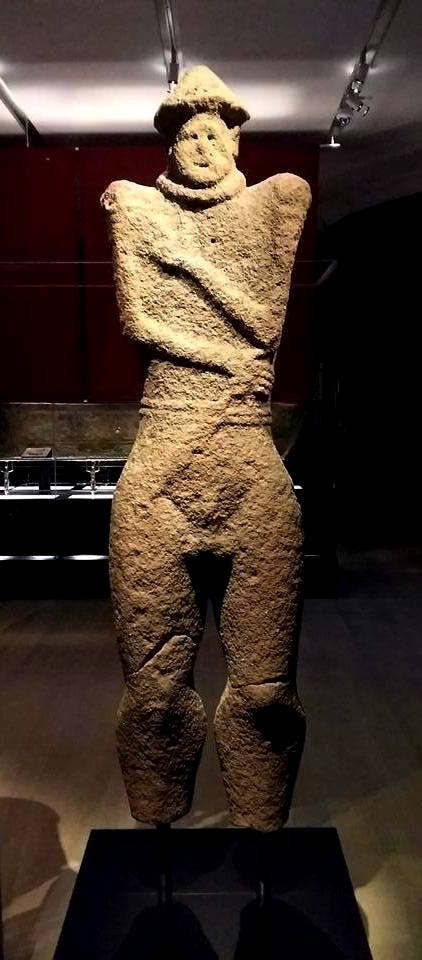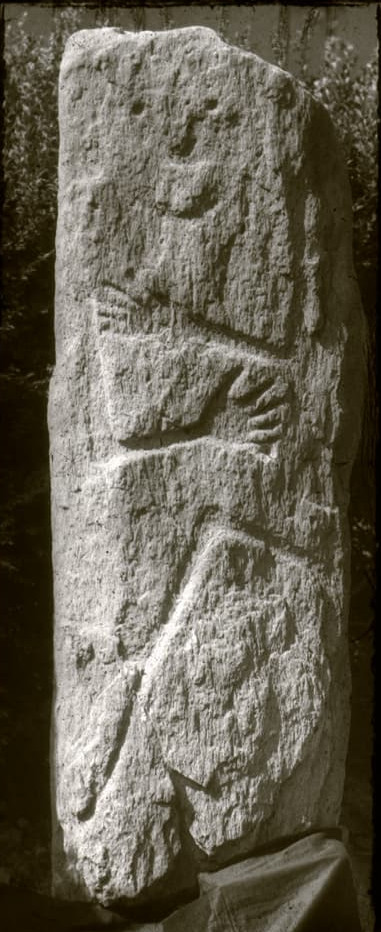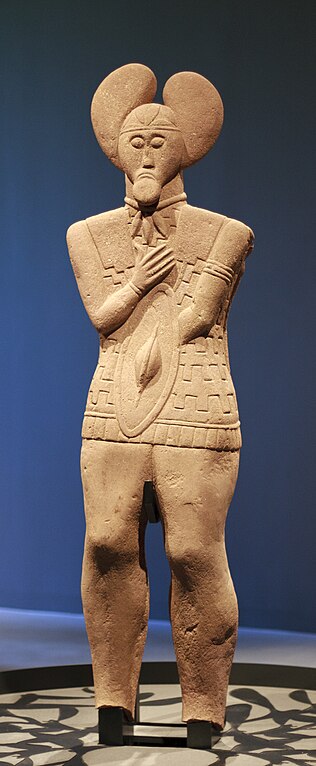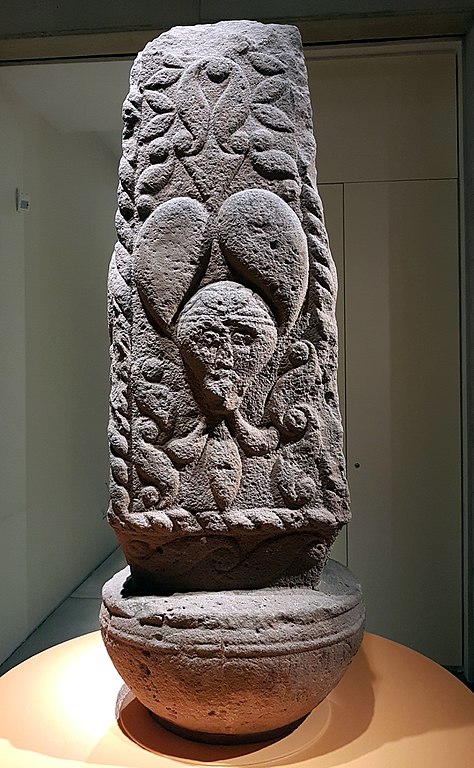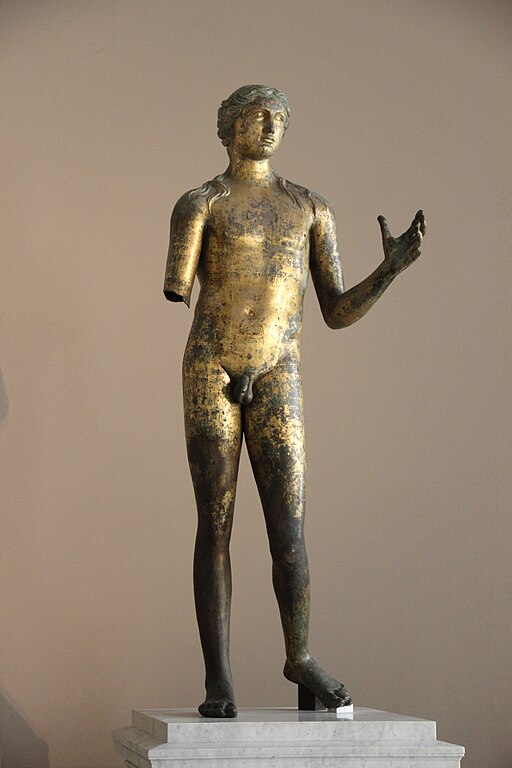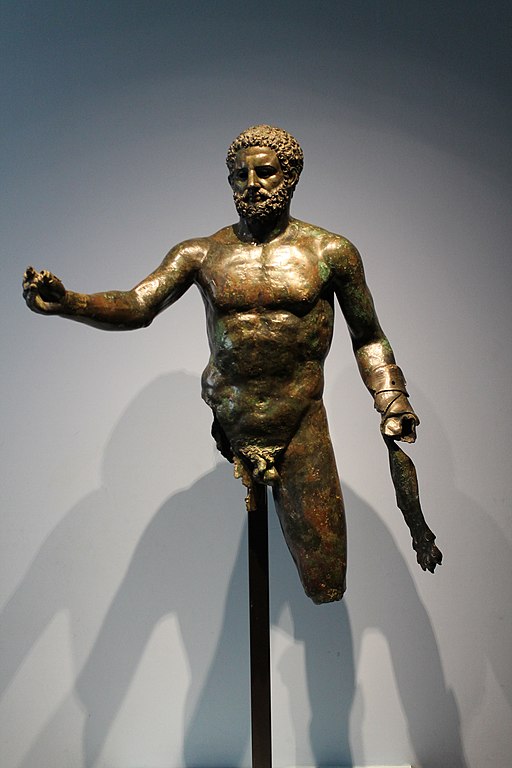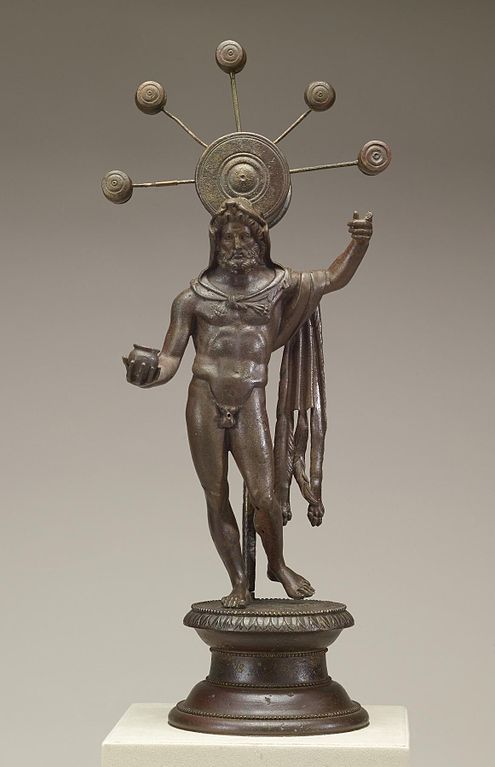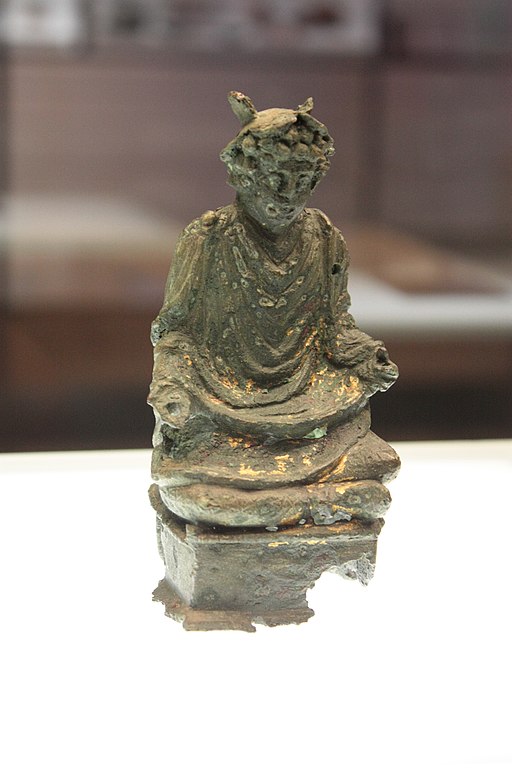Delvás
Delvás (idols) hold great importance in Gaulish religion today, much as they did in the past. While modern delvás not only continue providing a focal point for worship, those from antiquity teach valuable information about the cults they belonged to, making them key for understanding the historical religions.
This page focuses on ancient, anthropomorphic sculptures from Gaul and adjacent regions — not because animalian ones are discounted as possibly being delvás too, but because they are more difficult to identify as such, and probably deserve separate space to cover adequately.
Most anglophone Pagans will only find and learn about Gaulish delvás through English publications that are haphazard and systematically lacking key insights from current French and German scholarship — besides often being entrenched in flawed and eccentric Celticist theories.
The goal of this page is to start towards an accessible overview of Gaulish delvá fundamentals that better factors in continental scholarship. It will hopefully shed better light on an often dimly understood (despite so important) topic.
Table of Contents
- Classical Testimonies
- “Roman” or not?
- Typology
- Footnotes
- Bibliography
Classical Testimonies
The Gauls’ relationship (or lack thereof) to delvás was commented on in ancient literature. Perhaps the earliest example comes from Diodorus, who wrote in the middle of the 1st Century BCE. Drawing from Poseidonios who wrote earlier that same century, he recounts an anecdote about Brennus the Second — a Gaul who invaded Delphi in the 3rd Century:
Brennus, the king of the Gauls, on entering a temple found no dedications of gold or silver, and when he came only upon images of stone and wood he laughed at [the Greeks], to think that men, believing that gods have human form, should set up their images in wood and stone. (Bibliotecha Historia, 22.9.4)
Depending on which authors you read, this passage may be taken as proof that the Gauls were “aniconic,” eschewing human depictions of the Gods, or it may be dismissed out-of-hand as unreliable. Whether we want to believe it or not, the passage should be considered carefully since there is so little documentation on the subject.
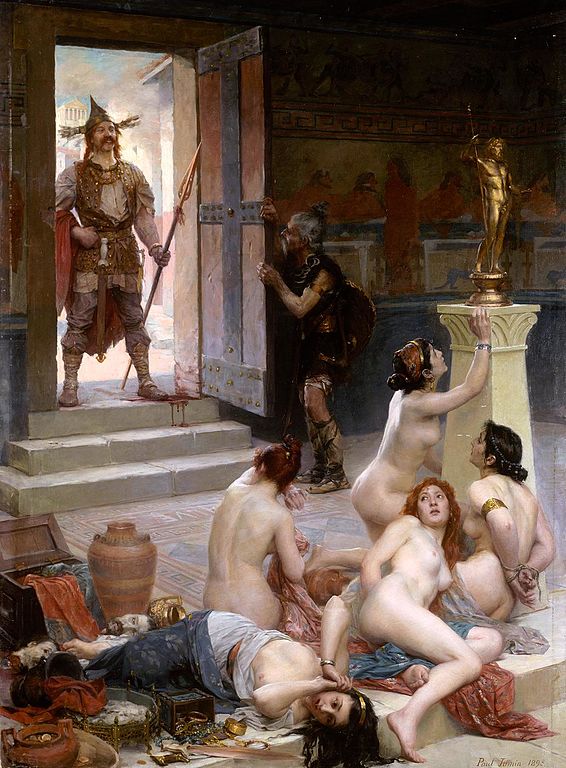
Gaulish art from Brennus’ time in the Second Iron Age has traditionally been considered to have a “lack of interest” in the human form (Adam, 2003). But more recent dating of artifacts changes this picture (as will be discussed in sections below). In contemplating how “iconic” the Gauls were or weren’t, we also can’t assume the relatively sparse stone or bronze sculptures that survive from his period represent all there was (absence of evidence is not evidence of absence, as they say). We can confidently say Gaulish art was also made out of perishable materials like wood that would be lost to time.
On the other hand, even if we know the Gauls produced some anthropomorphic sculptures and reliefs in Brennus’ time, it technically remains difficult to prove that they were used for idolatry. Perhaps the clearest material evidence of idols in Iron Age Gaul that we have would be the abundance of imported Etruscan bronze figurines (another thing that I will expand upon further below).
That said, Matthieu Poux’s insight into Diodorus (2020, p. 222-223) provides a persuasive argument against its reliability, which needs no support from archaeology:
The scene [from Diodorus] is clearly a topos, a literary motif aimed at underlining the impious ignorance of barbarian populations whose submission was just barely won under Augustus. The motif of the sacrilegious and iconoclastic barbarian is part of a long line of denunciation of the Persians, “looters of sanctuaries” (Jacquemin 2006, p. 286), and resurfaces on other occasions in Diodorus. For example, on the subject of the destruction perpetrated by the Carthaginians in Sicily: like Brennus, Himilcon is accused of destroying works of art and cult statues and in particular of having stolen, during the looting of Gela, a giant statue of Apollo sent to Tyre (Bibl. Hist., 13.108.1-4), which resulted in the Carthaginian armies succumbing to an epidemic, presented by the author as the manifestation of divine punishment (Bibl. Hist., 14.70.4-71; 14.76.1).
The comparison of the two passages sheds light on their general significance. As Alain Besançon (1994) showed, the question of divine representations constitutes one of the central themes of the current of Stoic thought, which irrigates the work of Diodorus in a more-or-less diffuse way (Sacks 1990, p. 36- 37, 64). The contempt for divine representations figures among the deviations of ubris theorized by Xenophon, whose influence on Zeno and the first Stoics is well recognized and permeates several notorious sources of the Histories of Diodorus such as Timaeus and Ephorus. Brennus and Himilcon, whose impiety (ἀσέβεια) is punished by a reversal of fortune due to divine intervention, are only two ethnic variants of the same moralizing vision of history, which says absolutely nothing about the reality of societies.
… The literary analyses carried out by M. Gaifman (2012) have demonstrated to what extent the notion of “aniconism” is linked, in Greek literature, to that of “primitivism” and superstition.1
While we may never know what Brennus really thought, Caesar’s witness of Gaul some two centuries later also offers a stark contradiction to Diodorus:
Of the Gods, [the Gauls] worship Mercury most. … Many statues are of him. (De bello gallico, 6.17).2
Unlike Diodorus, Caesar personally travelled Gaul extensively and had no apparent reason to fabricate this particular claim. While his expedition admittedly took place in a later time period than Brennus’, it still could be taken as proof enough that Gauls worshiped with delvás like other polytheists in Europe.
Ironically, though, while many imported Italian figurines have been found from prior to Caesar’s conquest of Gaul, none of them are identifiable to us as Mercury like Caesar says. Nor are they evenly distributed — meaning Caesar could have been generalizing based off of certain Gaulish tribes, while others possibly remained aniconic.
A third reference to Gaulish idols comes from Lucan’s Pharsalia (more properly known as De Bello Civili), which was written about a hundred years after Caesar’s account. The passage comes from Book 3, which recounts Caesar’s attack on the Southern Gaulish city of Massilia:
There stood a sacred grove, which for time immemorial was never profaned. Darkness cast from its interlocking boughs enveloped chill air and shadows within. … and gloomy effigies of the Gods, from unhewn trunks deprived of all art, shapeless loom there. (De Bello Civili, 3.399-412) 3
As a poet, Lucan provides quite a bit more detail than Caesar did, to furnish a dramatic scene. It’s unclear whether Lucan had ever seen the inside of a nemeton himself, or if he was drawing from secondhand accounts. But as a Roman born in Spain but educated in Greece, he very well could have — and maybe even visited Massilia itself along the way.
In any case, his description of the idols in the grove corresponds well to Celtic wooden bustes from the La Tène period, such as those found in Switzerland (despite his disagreeable disparagement of them!) So ironically, the lurid account written by a young man for entertainment is evidently the most informative and true of the Classical sources...
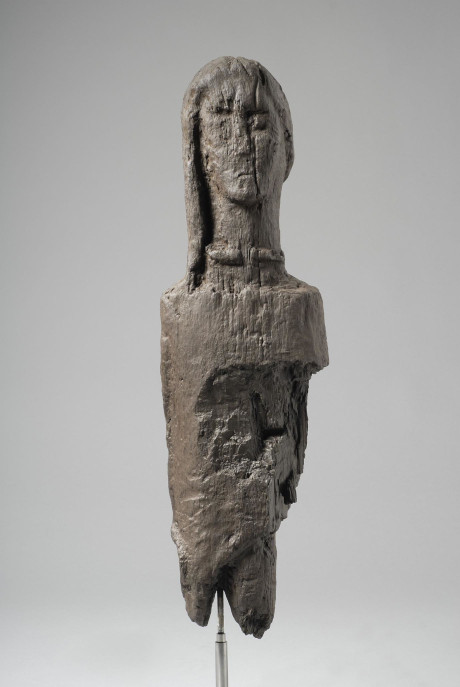
“Roman” or not?
As we’ve already seen from just a brief excursion through the Classical sources, there are problems with discussing “Gaul” as a singular or cohesive concept across time and space. And while we often see the subject of Gaulish culture and society framed in opposition to Rome through terminology like “Independent” or “pre-Roman” vs. “Roman” Gaul, those terms — especially for the purposes of art analysis — can be misleading.
For starters, “Gaul” was never fully “independent” for the time period we are examining, since Ionian Greeks were already colonizing Massallía in the 6th Century BCE. Hallstatt and La Tène figurative art certainly wasn’t “independent” either (as no art style really is), since they exhibit notable Greek and Etruscan influences. Some of the most popular Gaulish idols in that era were imported Etruscan bronze “Hercules” figurines, as I’ve mentioned.
This makes labelling Gaulish art of the time “pre-Roman” somewhat awkward, as that label has traditionally been used to give a false sense of untouched indigeneity, free from Mediterranean influence (note that many Celtic societies were Mediterranean themselves).
This earliest period could certainly be considered “pre-Roman,” but moreso in the strictest sense: Rome had not even ascended to power yet! The predominant society in Italy at the time were the Etruscans, and their culture and wares had evidently made inroads far into Gaul already.
It’s also worth keeping in mind that Narbonensis had already been absorbed as a Roman province some sixty years before Caesar’s conquest of Gaul, and must have had ties even earlier than that.
While Caesar’s invasion was obviously transformative, and involved a global imposition of Imperial religion unlike before, it’s still a mistake to see it as the inception point for which Italian art and religion were first introduced there — and on the flip-side, to see it as an end to the Celtic art and religion there!
Iron Age symbolism, and sometimes even style, persisted well into the Roman era of Gaulish sculpture, showing far greater continuity than is commonly supposed, as we will see below.
Taken altogether — how the Celticity of Gaulish art never fully disappeared and how “Roman” art, at a minimum, was always some admixture of different Hellenistic and Italic styles over time — what, then, is the value of treating earlier Etruscan and Hellenic influences on Gaulish art as categorically opposite from the “Roman” ones that followed? Purely historicopolitical?
Typology
But separate from style, symbolic content, or nebulous notions of “identity,” the Roman period is undeniable for its transformation of the modes of production in Gaul, which remains a useful, material demarcation from the prior “Iron Age” in our art analysis.
In spite of the fraught questions touched on above, I think careful examination can lead to a relatively straightforward rubric for analyzing different types of delvás:
Celtic sculpture
Celtic sculpture in Gaul appears to have evolved continuously from the Iron Age through the Roman period. However, this section will focus on the Iron Age artefacts, on account of what new contexts and great changes in consistency and style occurred after shifting to Roman modes of production, material techniques, and uses.
After that point, Celtic sculpture becomes grouped with the “provincial” type discussed further below.
The Celtic Iron Age is typically divided into two broad periods known as “Hallstatt” and “La Tène,” sometimes also called simply the “First” and “Second” Iron Ages. The statues are relatively few in number (especially for Hallstatt), and mainly only survive in stone, although some bronze and wood work has also been found. The increasing number of timber sculptures discovered from the Keltiké may suggest that wood was a common medium that unfortunately has just not survived in quantity.
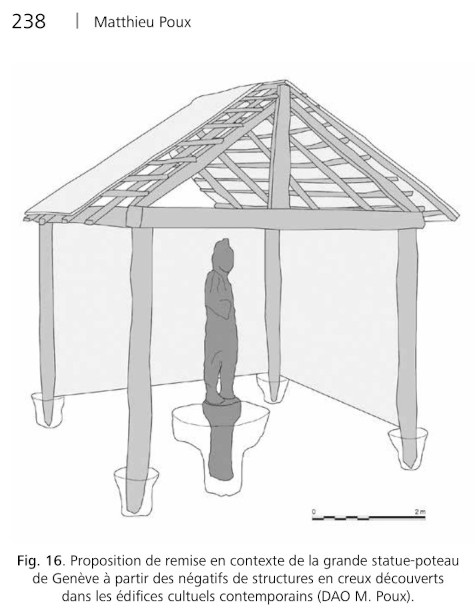
The absence of preserved woods in contemporary sanctuaries can be explained by the fact that they are generally located on prominent points of the landscape, in elevated and well-drained areas. (Poux 2019) 4
Pits found within pre-Roman Celtic “fana,” once thought to have been chthonic altars, are now considered post holes where delvás were orginally erected (Poux 2019).
In spite of Celtic art’s diversity over time and space, there are a few key signifiers of Celtic statues that remain typical across the different types:
- A torc
- A “Mistletoe” headdress (which may disappear in the Roman period)
- A cross-legged sitting posture
- Certain types of chimerism (generally antlered deities or horned serpents in statuary, but man-faced horses, and others also)
Not all of these keys need be present, and any one alone may be sufficient to place a statue as “Celtic” if the surrounding context supports it.
Another notable key might be “Janiform” and especially “Tricephalic” figures, except that it’s not always a useful diagnostic in practice since there are well-established Etruscan, Greek, and Roman Gods Who also appear this way. Nonetheless, tricephalic figures in “provincial” Gaulish sculpture are generally considered Celtic.
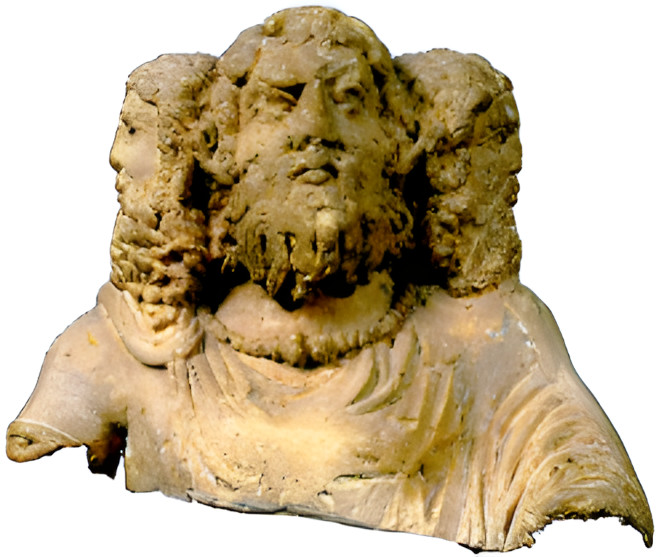
There are a few main formats of statues:
En pied — Full-figure standing statues that depict the body from head-to-toe.
Accroupie or en tailleur — Cross-legged sitting statues, simply put. They are full figured from head-to-toe, although may lack anatomical detail.
Pilier or hermès — A bust that figures the head in-the-round on top of a tall supporting base or column. The column itself may be blank, may have arms sculpted in relief, or may even be fully sculpted below the neck, but without figuring anything below the waist.
Stèle — A type of stela that can be similar to a pilier or hermès, except for being sculpted entirely in relief. Stèles may also vary considerably in size, shape, and figurative strategy.
Buste sur socle — Similar to a hermès, except referencing statuettes which have smaller or more proportional bases rather than a supporting column.
Heads — Heads without any base or columnar attachment.
Hallstatt-La Tène
Hallstatt and La Tène are names of Iron Age cultures from Central and Western Europe that are traditionally associated with “the Celts.” While Hallstatt’s Celticity is challenged by archaeologists (since it must have been shared by other linguistic groups too), the earliest phase of Gaulish figurative art nonetheless falls firmly within “Hallstatt.”
Although Hallstatt culture as a whole covered a broad timespan from the 12th Century BCE, Gaulish figurative art probably doesn’t emerge until the 8th Century (keeping in mind the difficulties of dating most of the statues from this epoch), otherwise known as “Hallstatt C” (out of the four conventional periods, A-D).
Duceppe-Lamarre (2002) identified five regions of Celtic Iron Age sculpture, four of which would fall within or adjacent to Gaul. They each have different associated styles, and can vary as much by region as by time period, making generic “Hallstatt” or “La Tène” groupings seem ill-suited when discussing types of statuary.
While not exhaustive, the primary categories are broken down as such:
South German Hallstatt Statues and Stèles
The earliest of this group probably dates to around the 7th — 6th Centuries BCE. These stèles and statues en pied were locally made in Southern Germany, but “find analogies with Mediterranean sculpture” — for example the Hirschlanden Warrior comparing favorably to the Capestrano Warrior from Italy, or Celtic Hallstatt statues from Iberia.
These works are typically associated with funerary contexts, whose burials likewise feature both local-made furnishings and imports from Cisalpina. While the more legible statues and stèles depict ithyphallic warriors that are compared to Greek kouroi, the more minimal reliefs en stèle convey little else beyond stick-figures (with disarmingly jolly appearances).
Greek and Etruscan Imports
While not one of Duceppe-Lamarre’s categories, since at least the 7th Century BCE Greek and Etruscan figurines are found even well North into Gaul, further emphasizing the already evident links and influences of Mediterranean art (Boucher 1976). These sorts of “archaic” Mediterranean pieces would continue to be found into the La Tène period.
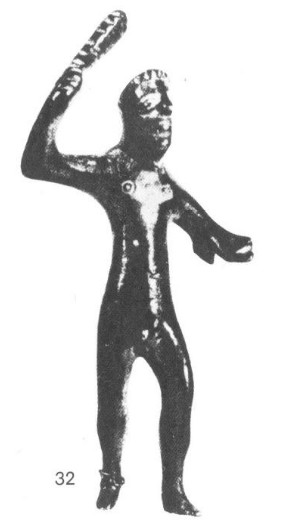
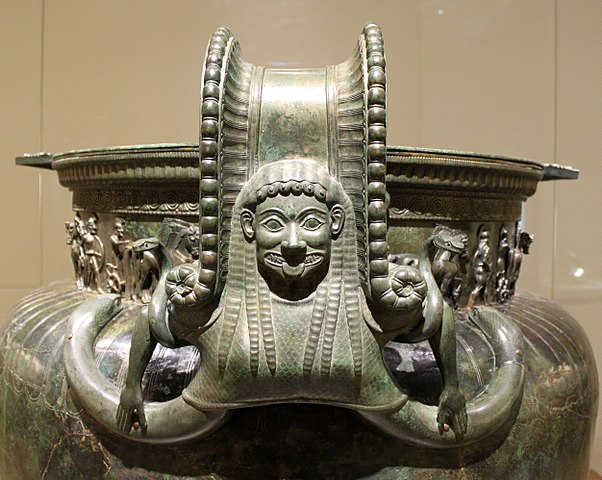
2. Gorgon handle on the Vix Krater (source)
Stéphanie Boucher (1976) details how some Greek and Etruscan style bronze figurines appearing in Gaul probably by the 6th Century BCE may be identifiable as certain Gods — some are identified as Mars, Apollo, and Jupiter — but most notably between the 4th and 2nd Centuries Hercle (the “Etruscan Hercules”) grows to be the most abundant figure by far. Some other types from this period are praying priests and priestesses, or figures with “radiant crowns” like Sol giving libations.
Interestingly, while most of these figurines appear to be imports, in at least some cases they may have been replicated locally (Boucher 1976), although this assessment seems based on subjective stylistic criteria.
Geometric and Curvilinear Armorican Stèles
This group, made up of various sized decorative stelae, is genuinely aniconic, although it could have existed alongside the later anthropomorphic Armorican bustes sur socles group that will be covered further below. Its designs are compared to stamped Armorican ceramics from the 5th Century, as well as Greek painted ceramic or mosaic designs. Unlike the other groups, the Armorican context shows a low presence for Mediterranean artifacts. Despite having designs similar to Mediterranean décor, its physical format is more comparable to stones found in Ireland.
While sometimes located in funerary contexts, these sculptures are often ex situ or spolia, making dating difficult — although more recent discoveries have been dated to La Tène A5.
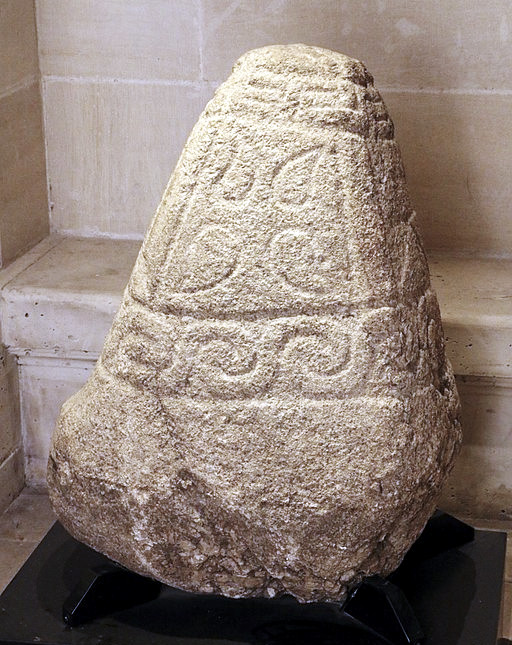
Mistletoe Headdresses from the Rhineland
This group from the Upper and Middle Rhine stands out for its ostentatious headgear, dubbed feuilles de gui (mistletoe leaves), believed by Duceppe-Lamarre to have originated out of La Tène vegetal ornamentation that was then transferred to these monumental stone carvings. While that theory seems unprovable, it is hard to counter with a better alternative — and indeed difficult to imagine such a shape existing as an actual hat.
While showing stylistic continuity with the older German Hallstatt statuary to the South (mentioned above), this is tentatively placed by Duceppe-Lamarre in the early La Tène.
Cross-legged Statues and Heads in Southern France
These headless statues, concentrated in Narbonensis (specifically Eastern Languedoc and Western Provence), are best known from the sites of Roquepertuse and Entremont. Besides their iconic cross-legged posture, they are remarkable among Celtic statues for their anatomical realism and vibrant, geometric, polychrome clothing patterns (the polychromy being similar to the Celtic Hallstatt warrior statues from Portugal). Their breastplates and swords are indicative of warrior figures.
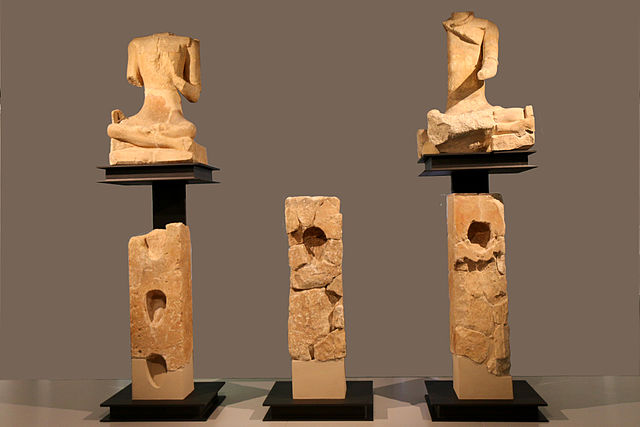
Although traditionally dated to later La Tène (3rd - 2nd Centuries), Duceppe-Lamarre notes that more recent discoveries could push the dating back to the 5th — 3rd Centuries.
While both sites may feature torques and cuirasses, Roquepertuse and Entremont have fairly different styles of clothing. Only one statue from Entremont is cross-legged, and unlike Roquepertuse, some of the statues there are female.
The cross-legged figures are understandably interpreted as “warriors,” given their armor and occasional weaponry. The disembodied heads are also taken to have a martial connotation. However, in the Roman period, statues accroupies are usually recognizable as Gods, such as Cernunnos, one of the Matres Cernunnae, Mercury, Sucellus, etc. — which should give us pause at the tendency to view virutally every single Iron Age instance of this posture as not a God.
Another noteworthy entrant in this Southern Gaulish genre is a statue from Glanum, this time with an exposed membrum virile. A very similar “virile” cross-legged statue appears further North in Mainz, albeit much later, in the Roman period (Guillaumet, 2003).
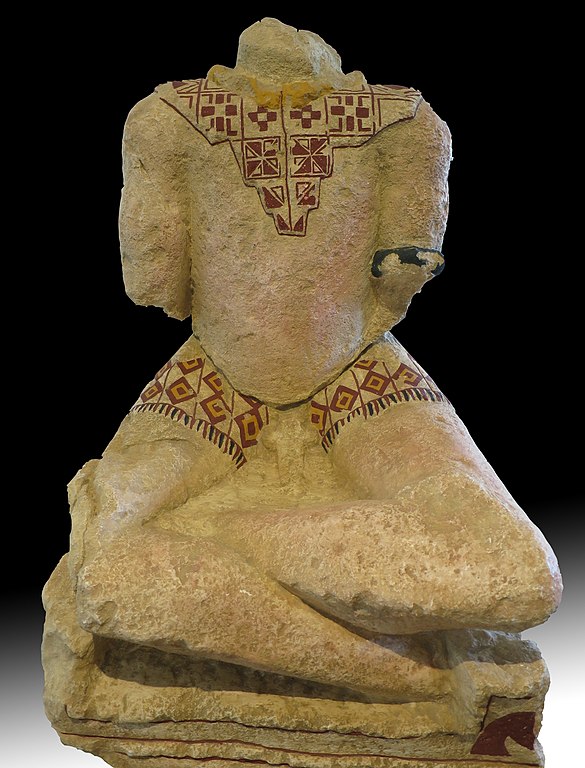
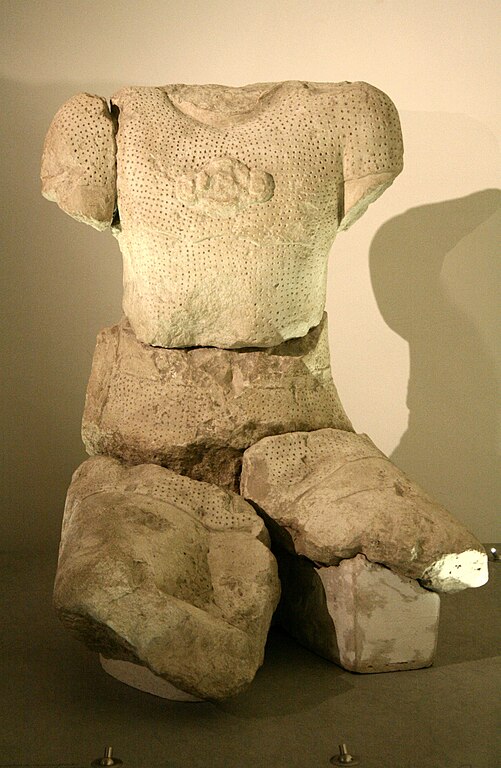
2. Seated warrior from Entremont (source)
Besides the busts and seated figures are a number of sculpted heads (which are not necessarily linked to the headless statues that accompany them). Roquepertuse features a two-headed Janiform hermès. While it’s not often mentioned in discussions of Gaulish aniconism, it’s worth pointing out that in every other European cultural context, Janiform and tricephalic figures are identified as Gods — so why should Gaul be any different?
Entremont features a collection of many single-head sculptures, in which Duceppe-Lamarre detects Hellenistic stylistic influences.
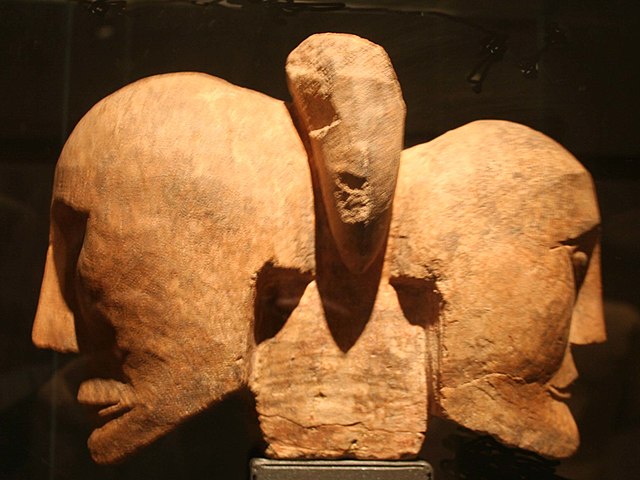
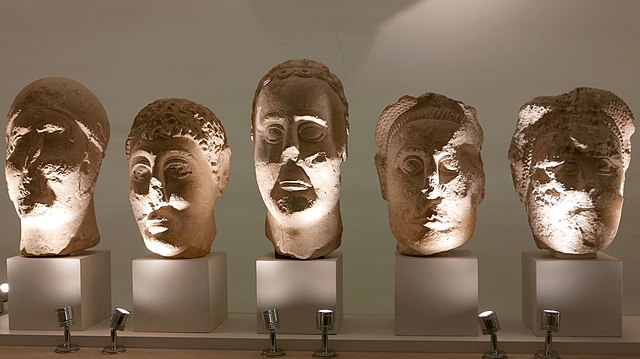
2. Heads from Entremont (source)
Bronze Figures Accroupies
While not being cohesive enough to constitute one of Duceppe-Lamarre’s categories, it is worth mentioning some other Iron Age sculptures accroupies from elsewhere in Gaul.
From the Rhineland comes the exquisite “Glauberg Jug,” a bronze La Tène A oenochoe that has a small cross-legged figurine at the top. He is dressed in a cuirass similar to the statues from Narbonensis, and accompanied with two sphynxes.
A bit later, supposedly the 1st Century BCE, is the famous dieu de bouray, a statue that’s fairly similar to those of the Narbonensis type, except that its cast in bronze with striking glass eyes, and its anatomical execution is less proportioned.
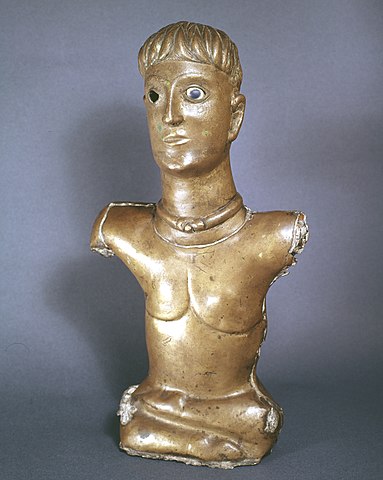
Bustes sur socles
Since the late 1980’s, an increasing number of bustes sur socles (“busts on pedestals”) have been unearthed, with the two main clusters centering on Brittany and Central France (Ménez, 1999). They are not geographically isolated, however, as they have been found as far South as Nîmes. Some are dated to La Tène C and D (~250 BCE onwards), and in one case a buste is dated afterwards in the 1st Century CE, while most of them lack adequate dating.
These bustes sur socles are generally considered to be ancestral effigies like the Hallstatt statues before them, except this time by way of comparison with ancestral simulacra from Rome, since their affinity is for domestic sites rather than funerary ones. However, some have been found in wells or accompanied with antlers and a couple are associated with sanctuary sites — seemingly pointing more towards a votive context.
Which could certainly lead one to wonder why the bustes should not be considered delvás of Gods (keeping in mind that the boundary between ancestors and Gods is hardly a firm one).
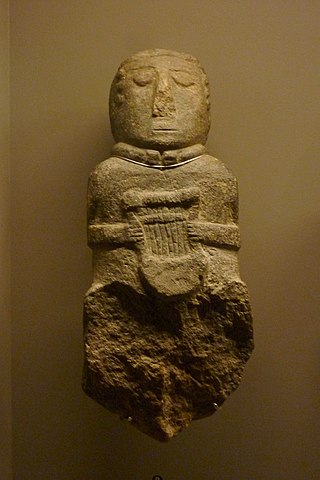
Ménez (1999), the source of the ancestral interpretation for the bustes, freely admits that his view, while based in evidenced comparisons and analysis, is also in part a « sentiment, nécessairement subjectif. » The diversity and unique characterization of each buste is one factor that leads Ménez to believe these are personal depictions of deceased family members.

On the Matter of Divinity
A recurring theme throughout French and other European literature is that none of these many figures are Gods — something Poux calls “one of the most dogged platitudes” of the field.5 While this may have origins in Diodorus, modern scholars generally don’t make reference to him. Poux (2019) instead traces the tendency back to Solomon Reinach’s premature declaration in 1890 that no pre-Roman idol has ever been found in Gaulish soil.
I can speculate at least one other reason European archaeologists probably avoid labeling anthropomorphic art from the proto-historic period as Gods: we have almost no documentation or criteria by which we can securely identify Them! Even the few Celtic deities Who have well-established and relatively unambiguous iconography (e.g., Cernunnos, Taranus, Epona, Sucellus, etc.) have yet to appear by this period, with at least one notable exception:
The Gundestrup Cauldron is obviously significant for providing an irrefutable example of theistic illustration from the late Second Iron Age (Cernunnos and probably Taranus being our main diagnostics in this case).
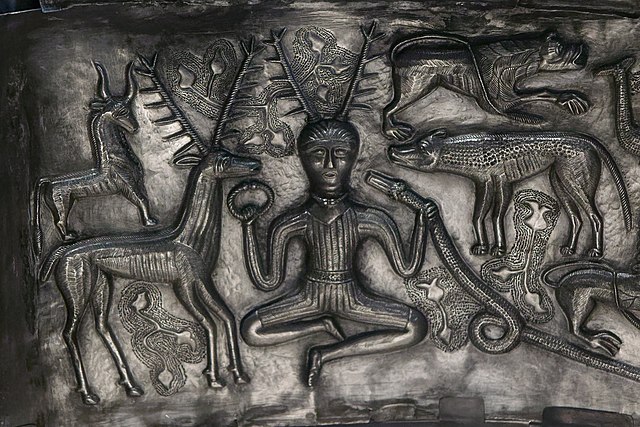
Another factor may be archaeologists seeking explanations that seem more specific or less obvious than Gods. For example, what Poux calls, “the syllogism … of deducing a function from a depositional environment” — i.e., when figures are found in the domestic sphere, they must be “ancestral effigies”; when found in the necropolis, they must be funerary memorials — and so forth.
These interpretations are not bad ones (albeit seemingly blind to the omnipresence of household shrines in polytheistic practice), but it can stray into the realm of rigid dogma when we find such figures in clear votive contexts, or ex situ, but still get them uniformly categorized as atheistic by scholars. At that point, the authors seem almost afraid to find any Iron Age delvás.
But it would defy plausability, in my mind, that we have found so many anthropomorphic effigies in Gaul, even within what are probably votive contexts, without any of them being delvás...
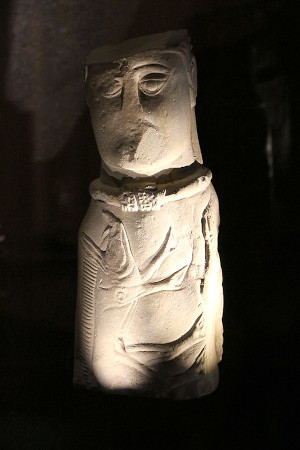
Although it is generally excluded from research on the more newly-discovered bustes sur socles, there is one sculpture from Euffigneix, discovered in 1922, that is typically described as a God (Blanchet, 1930; Musée d’archéologie nationale, n.d.)
Le Dieu d’Euffigneix, whose more detailed and refined sculpture is in a rather different style than the other bustes nonetheless looks comparable to other types of La Tène art. Le Dieu d’Euffigneix is suggested to date from 125 — 80 BCE.
The Euffigneix bust’s categorization as a God probably owes to different standards of scholarship at the time it was found. But it could also be due to the large boar and eye that are emblazoned on its torso, which seem to imbue it with some greater symbolic significance like one might expect of religious art.
On the other hand, the Devil’s Advocate could point out that this might just as well represent tattooage or other body art, and the lack of it found on other bustes should not rule out their own divinity, either.
The Roman Period
After the Roman conquest, stone and bronze idols proliferate in Gaul. While it may seem easy to dismiss this phenomenon as “more of the same” from Rome, close examination reveals Gallo-Roman religion to have quite its own character, which remained a well-spring of insight into the Gaulish traditions.
The amount of material to analyze from this period means that the following sections will necessarily be even more summarized and less thorough than the Iron Age sections above. The religious art of the Roman period forms something of a spectrum, ranging from more standardized and Hellenistic on the one hand, to more “Provincial” or “Celtic” on the other. I’ve divided this range into what I consider three identifiable and meaningful groups:
Classical
This category should already be well-known. “Classical” here refers primarily to Hellenistic art styles and their Roman variants. Whether imported or locally-produced, these works found in Gaul are basically indistinguishable from their counterparts in Greece and Rome, both in form and content.
Classical art can be diverse, but usually draws from a rather regimented canon of icons and subjects. It is instantly recognizable for its characteristic poses, naturalistic (though not necessarily realistic) anatomy, and fine detail — at least in monumental and large-format works.
The category should not, however, signify a particular standard of quality or workmanship — because while some pieces reach the highest rank of that, most Classical pieces are relatively smaller figurines or reliefs in local stone. They generally have less detail and “fine art” appeal than do monumental and marble works.
African and Near Eastern
This is a subset of Classical art because of how the pieces are typically of the Hellenistic or “Romanized” sort, but not having any perceptible Gaulish or Celtic influence. Many cults orginating from places like Syria, Anatolia, and Egypt enjoyed popularity in Britain and Gaul, and carried with them their accompanying idols (e.g., Mithras, Cybele, Ammon, Isis, Serapis, Harpocrates, Hermes-Thoth, etc.)
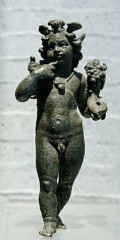
Metropolitan
Stéphanie Boucher, in her seminal work on Gaulish bronzes (1976), sought to identify what trends could distinguish Gaulish art in the Roman period. While much of it is indistinguishable from Roman or Hellenistic art (as discussed above), plenty also modified or diverged from the familiar forms:
Original thinking and aesthetics emerge through a conformity [to classical forms] that is more apparent than real. 6
These strains of Gaulish art, which I call “Metropolitan,” largely share the same style and quality of the Classical category, and draw from its same canon of icons. But they are distinguished (sometimes subtly, sometimes dramatically) by an assemblage of that canon in variations that are rare or even nonexistent outside Gaul.
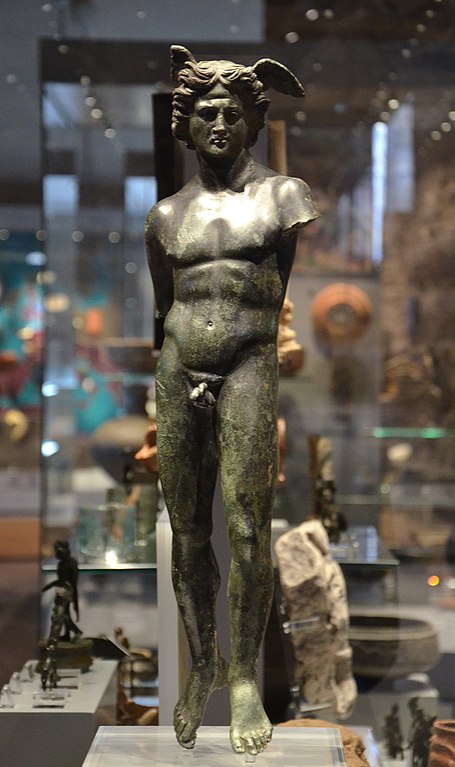
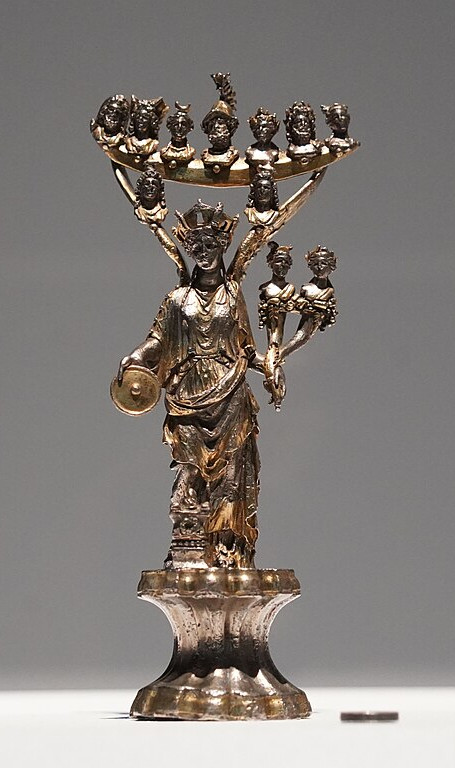
2. Tutela panthée du Trésor de Mâcon (source)
A textbook example would be a genre of nude — or as I say, “nudist” — Mercury bronzes. These Mercuries can come in any size and posture, but have in common that He eschews every article of clothing: No chlamys, no petasus, not even sandals. Wings sprout directly out of His hair instead of a hat. It’s only a subtle difference from the Classical design which is mostly nude anyway, but remarkable enough to comment on for its deliberacy, since Mercury’s few articles of clothes are otherwise so emblematic.
A similar genre exists for Mars, Who wears nothing but a helmet, or Who may be depicted as a youth.
A more dramatic departure is what I call the “enthroned” Mercury motif. This represents Mercury in the stance and garb of Jupiter or Zeus seated on His throne. To my knowledge, this variant is unlike any Classical Mercury depiction outside Gaul, and is largely confined to Germania Superior.
Another example is the “swaying” Apollo, Whose most distinctive trait I find to be His limp wrist, which may have rested on a now-lost lyre.
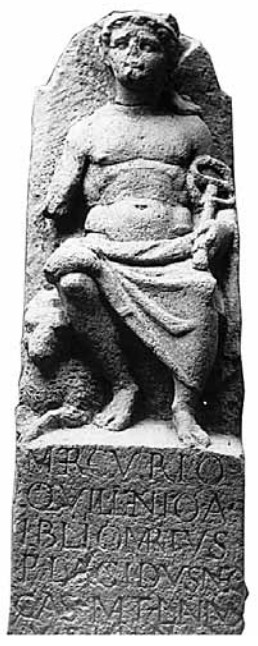
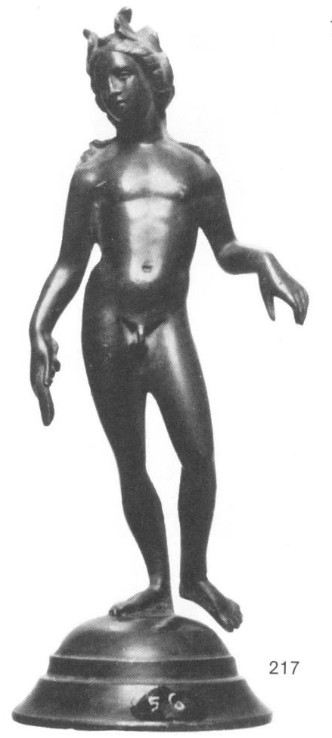
2. Apollon déhanché from La Comelle (Boucher 1976)
There is also the Gaulish tendency to depict Gods as consorts or pairs where They would normally have been solo in Rome. Perhaps a more extreme form of this is a genre called panthée, where a God is adorned by the heads of numerous other Gods.
While I just highlighted some distinctive examples to illustrate the “Metropolitan” category, we must note that not all Metropolitan works are consistent or obvious. Provincial artisans could take liberty with Classical motifs here-or-there, as the spirit moved them. Any Classical artwork from Gaul that noticeably strays from its orginal repertoire can be included here.
Caution is warranted, though: We don’t necessarily have the full picture of the canon as it was depicted outside Gaul. Small figurines or other more marginal pieces, for example, simply may not be exhaustively cataloged or analyzed for comparison to their Gaulish counterparts, which could lead us to falsely suppose something belongs here when it doesn’t.
Provincial
This is a stylistically more diverse category than the first two, and is primarily defined by its inclusion of Celtic features (as delineated earlier in this article) that are not a part of the Classical repertoire (except perhaps for Classical depictions of Gauls themselves).
Some Provincial pieces may totally match the criteria of Metropolitan art, but have just one element that stands out as Gaulish to place it here. For example, the famous Sucellus statuette from Vienne subtly blends Herculean, Silvanian, and Jupiterian iconography in a fine Metropolitan style, but shows Him holding forth an olla while standing before His mallets-upon-mallets, arranged in a ray behind Him like the sun. If either of those two elements were lost (as often happens), this piece would not even be recognizable as Provincial.
In other cases, pieces may meet Classical art standards while depicting a much more extensively “indigenous” deity. The Reims Stela is a good illustration of this, where Cernunnos is flanked by Apollo and Mercury. The stela’s columns and tympanum are utterly Roman in design, but Cernunnos, by contrast, is resplendent with un-Roman attributes: His antlers, torc, cross-legged sitting posture, and the pouring of grain below to the stag and bull.
Conversely, “Roman” Gods can be portrayed in a more Gaulish way, such as the Mercury from Pouy-de-Touges, Who sits cross-legged.
Another type we find is an otherwise Classical-looking God with no unusual attributes, except for being clothed in Gaulish-style garb — long-sleeved tunics or full-length ponchos, for example.
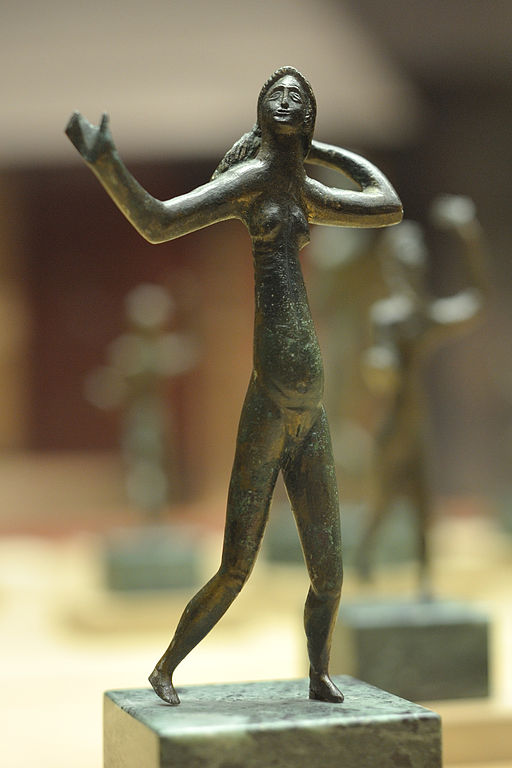
2. La danseuse from Neuvy-en-Sullias (source)
On the furthest end of the spectrum, some pieces may have no discernably Classical attributes at all. These ones, which are less common, may instead resemble statuary from the earlier Hallstatt and La Tène eras. This is not necessarily a matter of quality, either. The treasure from Neuvy-en-Sullias, for example, contains finely crafted bronzes, but with highly unnatural proportions — as if some sort of stylistic revival and evolution of Gaul’s Etruscan bronzes of yore — in any case, a clearly deliberate departure entirely from the Classical forms found in situ right beside them.
Footnotes
-
Original text:
La scène relève à l’évidence du topos, motif littéraire visant à souligner l’ignorance impie de populations barbares dont la soumission était à peine acquise sous Auguste. Le motif du barbare sacrilège et iconoclaste s’inscrit dans une longue lignée de dénonciation des Perses « pilleurs de sanctuaires » (Jacquemin 2006, p. 286) et resurgit à d’autres occasions chez Diodore. Par exemple, au sujet des destructions perpétrées par les Carthaginois en Sicile : comme Brennus, Himilcon est accusé de destructions d’objets d’art et de statues de culte et en particulier d’avoir volé, lors du pillage de Gela, une statue géante d’Apollon envoyée à Tyr (Bibl. Hist., 13.108.1-4), ce qui vaudra aux armées carthaginoises de succomber à une épidémie, présentée par l’auteur comme la manifestation d’un châtiment divin (Bibl. Hist., 14.70.4-71 ; 14.76.1).
Le rapprochement des deux passages éclaire bien leur portée générale. Comme l’a montré Alain Besançon (1994), la question des représentations divines constitue l’une des thématiques centrales du courant de pensée stoïcien, qui irrigue l’œuvre de Diodore de façon plus ou moins diffuse (Sacks 1990, p. 36-37, 64). Le mépris des représentations divines figure parmi les déviances de l’ubris théorisées par Xénophon3, dont l’influence sur Zénon et les premiers stoïciens est bien reconnue et imprègne plusieurs sources notoires des Histoires de Diodore tels que Timée et Ephore. Brennus et Himilcon, dont l’impiété (ἀσέβεια) est punie par un revers de fortune dû à l’intervention divine, ne sont que deux variantes ethniques d’une même vision moralisatrice de l’histoire, qui ne dit absolument rien de la réalité des sociétés
...
Les analyses littéraires menées par M. Gaifman (2012) ont démontré à quel point la notion « d’aniconisme » est liée, dans la littérature grecque, à celle de « primitivisme » et de superstition.
(back) -
Original text:
Deum maxime Mercurium colunt. Huius sunt plurima simulacra: hunc omnium inventorem artium ferunt, hunc viarum atque itinerum ducem, hunc ad quaestus pecuniae mercaturasque habere vim maximam arbitrantur. (De bello gallico, 6.17).
(back) -
Original text:
lucus erat longo numquam violatus ab aevo obscurum cingens conexis aera ramis et gelidas alte summotis solibus umbras.
(back)
... simulacraque maesta deorum arte carent caesisque extant informia truncis. (De bello civili, 3.399-412) -
Original text:
L’absence de bois conservés dans les sanctuaires contemporains s’explique par le fait qu’ils sont implantés, en règle générale, sur des points saillants du paysage, dans des terrains surélevés et bien drainés.
(back) -
Original text:
L’absence de représentations divines anthropomorphes dans les sanctuaires gaulois antérieurs à la conquête romaine compte parmi les lieux communs les plus inoxydables de la recherche protohistorique française et européenne.
(back) -
Original text:
une pensée et une esthétique originales se font jour à travers un conformisme [aux formes classiques] plus apparent que réel.
(back)
Bibliography
- Adam, A.-M. (2003). « De l’imagerie hallstattienne aux décors laténiens: Quelles filiations? Décors, Images et Signes de l’âge Du Fer Européen » (PDF link). Actes Du XXVIe Colloque de l’Association Française Pour l’étude de l’âge Du Fer, 24, 27–36.
- Blanchet, J.-A. (1930). « Le torse celtique d’Euffigneix (Haute-Marne). » Monuments et Mémoires de La Fondation Eugène Piot, 31(1), 19–22.
- Boucher, S. (1976). Recherches sur les bronzes figurés de Gaule pré-romaine et romaine (Vol. 228). Persée-Portail des revues scientifiques en SHS.
- Duceppe-Lamarre, A. (2002). « Unité ou pluralité de la sculpture celtique hallstattienne et laténienne en pierre en Europe continentale du VIIe au Ier s. Av. J.-C. » Documents d’archéologie Méridionale. Protohistoire Du Sud de La France, 25, 285–318.
- Guillaumet, J.-P. (2003). « Les personnages accroupis: Essai de classement » (PDF link). Décors, Images et Signes de l’âge Du Fer Européen. Actes Du XXVIe Colloque de l’Association Française Pour l’étude de l’âge Du Fer, 24, 171–182.
- Hupe, J. (1997). „Studien zum Gott Merkur im römischen Gallien und Germanien.“ In Trierer Zeitschrift-Archäologie und Kunst des Trierer Landes und seiner Nachbargebiete (pp. 53–227).
- Ménez, Y., Giot, P.-R., Laubenheimer, F., Le Goff, E., & Vendries, C. (1999). « Les sculptures gauloises de Paule (Côtes-d’Armor) » (PDF link). Gallia, 357–414.
- Poux, M. (2019). « Huius sunt plurima simulacra: L’absence de statues de culte dans les sanctuaires gaulois » (PDF link). Sanctuaires de l’âge Du Fer. Actes Du 41e Colloque International de l’Association Française Pour l’étude de l’âge Du Fer, 1, 221–240.
